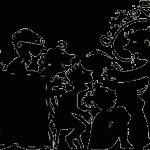[fusion_builder_container hundred_percent=”yes” overflow=”visible”][fusion_builder_row][fusion_builder_column type=”1_1″ background_position=”left top” background_color=”” border_size=”” border_color=”” border_style=”solid” spacing=”yes” background_image=”” background_repeat=”no-repeat” padding=”” margin_top=”0px” margin_bottom=”0px” class=”” id=”” animation_type=”” animation_speed=”0.3″ animation_direction=”left” hide_on_mobile=”no” center_content=”no” min_height=”none”]
As a museum educator, I work with all types of learners. Multimodal teaching is a phrase I hear on a consistent basis – and as a kinesthetic learner myself, I’m thrilled to use different styles to teach. I’m excited to see each new group and be a part of the class dynamic. My lessons and tours are planned with different learning styles in mind and ready to be adapted for any group.
But students aren’t the only unknown on a field trip – there are a few kinds of TEACHERS that I’ve come across in the museums I work with. After asking a few other educators, there are three very different general classifications of teachers that visit.
THE Teacher:
Overview: This type is a duality. They are THE super teacher – pushing limits every day. In the classroom: effective. The kids listen, are kept in line, learn well, and behave. But in another environment when another educator has the same goal? Disaster.
Signs: Interrupts educator, scolds kids for minor chatter when it is permitted, repeats everything the educator says – sometimes incorrectly, attempts to co-teach, leads the discussion and prompts the class for the ‘right’ answer.
Why it doesn’t work: Both the teacher and the educator have a common goal – to teach the class – but a museum is an informal educational environment. The control the teacher is placing on the class and the students is not always conducive to the museum education methodology. There generally are no ‘right’ answers; almost all statements are correct, especially when they are backed up by observations. When the teacher is continuously interjecting and attempting to co-teach, attention is divided and the students are distracted. And unless the educator and teacher chatted at length prior to the visit, the two are working against each other.
How to fix it: It’s hard to change – teachers see these students 99% of the time and chances are, this is a one off for the educator. The teacher either needs to accept another qualified educator teaching for a few hours or have an extended conversation WITH the educator (NOT the booking agent) about how to collaborate. Sometimes all it takes is a plan.
The Inattentive:
Overview: Just needs a break. Oh, a field trip? Another adult to lead the class? Someone else to work while I’m working! Vacation!! Angry Birds!
Signs: Disappears to the bathroom (for most of the trip), chats loudly the entire time with the chaperones, is either playing the most intense game of Angry Birds ever or writing a novel on their cell phone.
Why it doesn’t work: Some classes will still pay attention and it’s certainly better having someone not involved than interrupting every point. But teachers are the consistent role model for some of these students – if the teacher isn’t listening, why should the student? There is also that terrible moment when the natives try to take over. I won’t speak for all museum educators, but I am not a classroom teacher for many reasons. One is the idea of classroom management for MANY hours at a time. I have my bag of tricks that work only so well.
How to fix it: Take advantage of another trained professional teaching your students, but learn as well. Most museum educators spend hours working on a one-hour experience. If they are good, they put effort into finding information you will find interesting. And some kids come alive when they are at museums – you might be surprised. Put your phone away, please.
The Teacher We Love:
Overview: We know you. You’ve either been here before or answered our emails/calls/smoke signals. And you are ready. More importantly, your students were aware of the trip before they walk in.
Signs: This teacher exerts classroom management only when absolutely necessary. They participate to model – and they support the educator. The students know where they are and the general idea of the trip. (Example – They know they will be looking at art at the Guggenheim, not dinosaurs.)
Why it DOES work: A museum trip should be an opportunity for students to learn somewhere outside of the classroom. A collaboration between the educator and teacher can foster critical thinking, deeper understanding and work to the advantage of the classroom by exploring new strategies of learning. But they have to work together and share expectations and ideas.
These types do not encompass all teachers in a black and white manner. There are many shades of grey and everyone has different styles, experiences and expectations. And some museum educators prefer the teacher that is completely uninvolved and think a museum experience is solely separate from classroom learning. There are teachers that feel the same. If you aren’t one of those teachers – then start simple. Communicate, communicate, communicate. Sometimes, emailing and calling before the trip does not and cannot happen – let’s face it, we ALL have 1000 things to do. But some form of communication is imperative, even if two minutes are spent while the class is getting their coats off. Check in – it helps the educator AND your class.[/fusion_builder_column][/fusion_builder_row][/fusion_builder_container]



